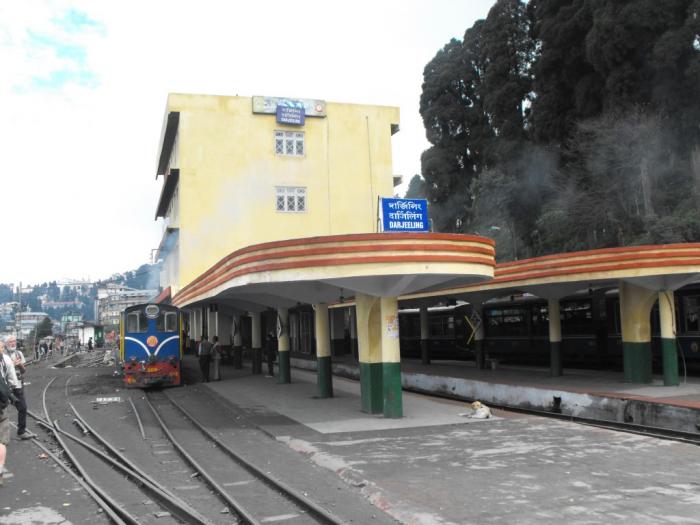Darjeeling Railway Station, Darjeeling Himalayan Railway. The Darjeeling Himalayan Railway, also known as the "Toy Train", is a 2 ft (610 mm) narrow gauge railway that runs between New Jalpaiguri and Darjeeling in the Indian state of West Bengal, India. Built between 1879 and 1881, the railway is about 78 km long. Its elevation level varies from about 100 metres at New Jalpaiguri to about 2,200 metres at Darjeeling. Four modern diesel locomotives handle most of the scheduled services; however the daily Kurseong-Darjeeling return service and the daily tourist trains from Darjeeling to Ghum (India's highest railway station) are handled by the vintage British-built B Class steam locomotives. The railway, along with the Nilgiri Mountain Railway and the Kalka-Shimla Railway, is listed as the Mountain Railways of India World Heritage Site. The headquarters of the railway is in the town of Kurseong. Operations between Siliguri and Kurseong were temporarily suspended since 2010 following a Landslide at Pagla Jhora and another near Tindharia in 2011. However normal Toy Train service has resumed between New Jalpaiguri and Darjeeling from 2nd December 2015.
History
A broad gauge railway connected Kolkata and Siliguri in 1878. Siliguri, at the base of the Himalayas, was connected to Darjeeling by a cart road on which carriage services were available. Franklin Prestage, an agent of Eastern Bengal Railway Company approached the government with a proposal of laying a steam tramway from Siliguri to Darjeeling. The proposal was accepted in 1879 following the positive report of a committee formed by Sir Ashley Eden, the Lieutenant Governor of Bengal. Construction started the same year.
Gillanders Arbuthnot & Co. constructed the railway. The stretch from Siliguri to Kurseong was opened on 23 August 1880, while the official opening of the line up to Darjeeling was on 4 July 1881. Several engineering adjustments were made later in order to ease the gradient of the rails. Despite natural calamities, such as an earthquake in 1897 and a major cyclone in 1899, the DHR continued to improve with new extension lines being built in response to growing passenger and freight traffic. However, the DHR started to face competition from bus services that started operating over the Hill Cart Road, offering a shorter journey time. During World War II, the DHR played a vital role transporting military personnel and supplies to the numerous camps around Ghum and Darjeeling.
After the independence of India, the DHR was absorbed into Indian Railways and became a part of the Northeast Frontier Railway zone in 1958. In 1962, the line was realigned at Siliguri and extended by nearly 6 km to New Jalpaiguri to meet the new broad gauge line there. DHR remained closed for 18 months during the hostile period of Gorkhaland Movement in 1988-89.
The line closed in 2011 due to a 6.8 Magnitude earthquake. The line is currently loss-making and in 2015, Rajah Banerjee, a local tea estate owner, has called for privatisation to encourage investment, which was fiercely resisted by unions.





